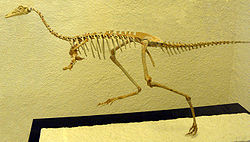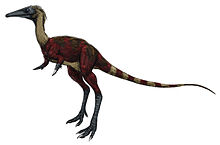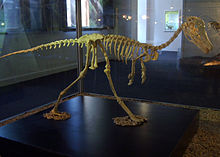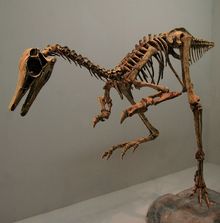- Alvarezsauridae
-
Alvarezsaurids
Temporal range: Late Jurassic-Late Cretaceous,
160–65.5 Ma
Reconstructed skeleton of Mononykus olecranus Scientific classification 
Kingdom: Animalia Phylum: Chordata Class: Reptilia Superorder: Dinosauria Order: Saurischia Suborder: Theropoda Superfamily: †Alvarezsauroidea Family: †Alvarezsauridae
Bonaparte, 1991Type species Alvarezsaurus calvoi
Bonaparte, 1991Subgroups Synonyms Bradycnemidae? Harrison & Walker, 1975 Parvicursoridae Karhu & Rautian, 1996
Mononykidae Chiappe et al., 1998Alvarezsauridae is an enigmatic family of small, long-legged running dinosaurs. Although originally thought to represent the earliest known flightless birds, a consensus of recent work suggests that they are primitive members of the Maniraptora. Other work found them to be the sister group to the Ornithomimosauria. Alvarezsaurs are highly specialized. They bear tiny but stoutly proportioned forelimbs with compact birdlike hands and their skeleton suggests they had massive breast and arm muscles, possibly adapted for digging or tearing. They have tubular snouts, elongate jaws, and minute teeth. They may have been adapted to prey on colonial insects such as termites.
Alvarezsaurus, and thus Alvarezsauroidea, Alvarezsauridae, and Alvarezsauria are named for the historian Don Gregorio Alvarez, not the more familiar physicist Luis Alvarez, who proposed that the Cretaceous-Tertiary extinction event was caused by an impact event.
Contents
Description
Alvarezsaurs range from 0.5–2 m (20–80 inches) in length, although some possible members may have been substantially larger, including the European Heptasteornis that may have reached 2.5 m (8 ft). Fossils attributed to alvarezsaurs have been found in North and South America and Asia, and range in age from the late Jurassic to the late Cretaceous periods, about 160 to 65 million years ago.[1][2]
Feathers
At least one specimen of alvarezsaur, from the species Shuvuuia deserti, preserved down-like, feathery, integumental structures covering the fossil. Schweitzer et al. (1999) subjected these filaments to microscopic, morphological, mass spectrometric, and immunohistochemical studies and found that they consisted of beta-keratin, which is the primary protein in feathers.[3]
History, study and debate
Bonaparte (1991) described the first alvarezsaurid, Alvarezsaurus calvoi, from an incomplete skeleton found in Patagonia, Argentina. Bonaparte also erected a monotypic family to contain it. He argued that it might be most closely related to the Ornithomimosauria.[4]
Perle et al. (1993) described the next alvarezsaur to be discovered, naming it Mononychus olecranus (meaning “one claw”). A month later they changed the genus name to Mononykus, because the earlier spelling was already the genus name of an extant butterfly.[5] Perle et al. (1993) mistakenly described Mononykus as a member of Avialae, and one more advanced than Archaeopteryx. They argued that the family Alvarezsauridae was actually a group of Mesozoic flightless birds on the basis of derived features that were unique to birds.[6] Novas (1996) described another member of the class called Patagonykus puertai.[7] Karhu and Rautian (1996) described a Mongolian member of the family; Parvicursor remotus.[8] Chiappe et al.(1998) described another Mongolian member, Shuvuuia mongoliensis and mistakenly found it to be even more derived, concluding that the alvarezsaurs were actually crown-group (that is, modern) birds.[9]
These mistaken assignments of alvarezsaurs to birds were caused primarily by features that are strikingly, or even uniquely, avian. The sternum, for example, is elongated and deeply keeled for an enlarged pectoralis muscle, as it is in neognathous birds and volant ratites. One bone in the skull of Shuvuuia appeared to be an ectethmoid fused to a prefrontal. The ectethmoid is an ossification known only in Neornithes. Other birdlike characters included the palatine, foramen magnum, cervical and caudal vertebrae, and many others.[10]
Several researchers disagreed with Perle et al. (1993) and Chiappe et al. (1998). Feduccia (1994), Ostrom (1994), Wellnhofer (1994), Kurochkin (1995), Zhou (1995), and Sereno (1997) considered it unlikely that alvarezsaurids were members of Avialae. Martin (1997) performed a cladistic analysis but Sereno criticized it strongly, finding it flawed by incorrect codings, use of only select data, and results that did not support his conclusions. Sereno (1999) performed a new analysis, revising the anatomical interpretations and clarifying the characters. He found that alvarezsaurids were more parsimoniously related to the Ornithomimosauria.[10]
As the more primitive members of the Alvarezsauridae were better characterized, the monophyly of the clade was strongly supported,[7] but the more primitive members lacked the most birdlike traits. Some of these traits had been misinterpreted, also. The remaining similarities between birds and alvarezsaurs, like the keeled sterna, are another case of homoplasy; where the derived alvarezsaurids developed birdlike characters through convergent evolution, rather than inheriting them from a common ancestor with birds.[10]
Classification
Taxonomy of Alvarezsauridae
Holtz, 2011[11] - Alvarezsauridae
- Achillesaurus
- Alvarezsaurus
- Bradycneme
- Ceratonykus
- Heptasteornis
- Patagonykus
- Parvicursorinae
- Albertonykus
- Albinykus[12]
- Kol
- Linhenykus
- Mononykus
- "Ornithomimus" minutus
- Parvicursor
- Shuvuuia
- Xixianykus
Turner et al. (2007) place the alvarezsaurs as the most basal group in the maniraptora, one step more derived than Ornitholestes and two more derived than the Ornithomimosauria. The alvarezsaurs are more primitive than the Oviraptorosauria.[13]
Novas' 1996 description of Patagonykus, demonstrated that it was a link between the more primitive (basal) Alvarezsaurus and the more advanced (derived) Mononykus, and reinforced their monophyly. Parvicursor was discovered shortly after, and placed in its own family Parvicursoridae, and then Shuvuuia in 1998. Everything has since been lumped into Alvarezsauridae, with Mononykinae surviving as a subfamily.
There may be a relationship between the alvarezsaurids and the Ornithomimosauria as sister clades within either Thomas Holtz's Arctometatarsalia or Paul Sereno's Ornithomimiformes. The discovery of Haplocheirus, which exhibits transitional features between the more derived alvarezsaurs and other maniraptorans, particularly in relation to the skull structure and development of the hand, has provided further support for that relationship.[14]
The taxonomy of the alvarezsaurs has been somewhat confused, due to different authors using different names for groups with the same definition. The family Alvarezsauridae was first coined by Jose Bonaparte in 1991, but given no specific phylogenetic definition. Novas later defined the group as the most recent common ancestor of Alvarezsaurus and Mononykus plus all its descendants, though others, such as Paul Sereno, used a more inclusive definition, such as all dinosaurs closer to Shuvuuia than to modern birds. In 2009, Livezey and Zusi used the name Alvarezsauroidea for the total group of all alvarezsaurs, restricting the name Alvarezsauridae to the clade defined by Alvarezsaurus + Mononykus. This was followed by Choiniere and colleagues in 2010, who described the first non-alvarezsaurid alvarezsauroid, Haplocheirus.[15] Some authors have used the name Mononykinae for the sub-group of alvarezsaurs including the advanced Mongolian species. However, Choiniere and colleagues argued that Parvicursorinae has priority, since its coordinate name under the ICZN Code, Parvicursoridae, was named earlier.[15]
The cladogram presented here follows a 2009 phylogenetic analysis by Nick Longrich and Phil Currie.[16]
Alvarezsauridae unnamed unnamed unnamed Unnamed alvarezsaur (YPM 1049)
Mononykinae unnamed Parvicursor sp. (Tugrik alvarezsaur)
unnamed Cladogram after Xu et al., 2011:[17]
Alvarezsauroidea Haplocheirus
Alvarezsauridae Parvicursorinae Linhenykus
Unnamed alvarezsaur (YPM 1049)
Xixianykus
Tugriken Shireh alvarezsaur
References
- Schweitzer, Mary Higby, Watt, J.A., Avci, R., Knapp, L., Chiappe, L, Norell, Mark A., Marshall, M. (1999). "Beta-Keratin Specific Immunological reactivity in Feather-Like Structures of the Cretaceous Alvarezsaurid, Shuvuuia deserti Journal of Experimental Biology (Mol Dev Evol) 255:146-157.
- Bonaparte, J.F. (1991). "Los vertebrados fosiles de la formacion Rio Colorado, de la ciudad de Neuquen y Cercanias, Creatcio Superior, Argentina” Rev. Mus. Agent. Cienc. “Bernadino Rivadavia”, Paleontol. 4:16-123.
- Perle Altangerel, Norell, Mark A., Chiappe, Luis M., Clark, James M., (1993). "Correction:Flightless bird from the Cretaceous of Mongolia” Nature 363, pg.188(13 May 1993
- Perle Altangerel, Norell, Mark A., Chiappe, Luis M., Clark, James M., (1993). "Flightless bird from the Cretaceous of Mongolia” Nature 362, pp. 623–626 (15 April 1993) doi:10.1038/362623a0
- Novas, F.E. (1996) “Alvarezsauridae, Cretaceous maniraptorans from Patagonia and Mongolia”. Mem. Qld. Mus. 39:675-702
- Karkhu, A.A., Rautian A.S. (1996) “A new family of Maniraptora (Dinosauria: Saurischia) from the Late Cretaceous of Mongolia.” Paleontol. J. 30:583-592.
- Chiappe, Luis M., Norell, Mark A., Clark, James M.(1998)“The skull of a relative of the stem-group bird Mononykus” Nature 392:275-278.
- Sereno, Paul. (2001). "Alvarezsaurids: Birds or ornithomimosaurs?" “In: New Perspectives on the Origin and Early Evolution of Birds” Gauthier, Gall editors. Yale Peabody Museum
- Turner, Alan H.; Pol, Diego; Clarke, Julia A.; Erickson, Gregory M.; and Norell, Mark.. (2007). " A basal dromaeosaurid and size evolution preceding avian flight". Science, 317: 1378-1381. doi:10.1126/science.1144066
- ^ Choiniere, J., Clark, J., Xu, X. and Fenglu, H. (2009). "A new basal alvarezsaur from the Shishugou Formation," Journal of Paleontology 29(3): 77-78A.
- ^ Hutchinson and Chiappe, 1998. The first known alvarezsaurid (Theropoda: Aves) from North America. Journal of Vertebrate Paleontology. 18(3), 447-450.
- ^ .Schweitzer, Mary Higby, Watt, J.A., Avci, R., Knapp, L., Chiappe, L, Norell, Mark A., Marshall, M. (1999). "Beta-Keratin Specific Immunological reactivity in Feather-Like Structures of the Cretaceous Alvarezsaurid, Shuvuuia deserti Journal of Experimental Biology (Mol Dev Evol) 255:146-157
- ^ Bonaparte, J.F. (1991). "Los vertebrados fosiles de la formacion Rio Colorado, de la ciudad de Neuquen y Cercanias, Creatcio Superior, Argentina” Rev. Mus. Agent. Cienc. “Bernadino Rivadavia”, Paleontol. 4:16-123.
- ^ Perle Altangerel, Norell, Mark A., Chiappe, Luis M., Clark, James M., (1993). "Correction:Flightless bird from the Cretaceous of Mongolia” Nature 363, pg.188(13 May 1993)
- ^ . Perle Altangerel, Norell, Mark A., Chiappe, Luis M., Clark, James M., (1993). "Flightless bird from the Cretaceous of Mongolia” Nature 362, pp. 623-626 (15 April 1993) doi:10.1038/362623a0
- ^ a b Novas, F.E. (1996) “Alvarezsauridae, Cretaceous maniraptorans from Patagonia and Mongolia”. Mem. Qld. Mus. 39:675-702
- ^ Karhu, A.A., Rautian A.S. (1996) “A new family of Maniraptora (Dinosauria: Saurischia) from the Late Cretaceous of Mongolia.” Paleontol. J. 30:583-592
- ^ Chiappe, Luis M., Norell, Mark A., Clark, James M.(1998)“The skull of a relative of the stem-group bird Mononykus” Nature 392:275-278.
- ^ a b c Sereno, Paul. (2001). "Alvarezsaurids: Birds or ornithomimosaurs?" “In: New Perspectives on the Origin and Early Evolution of Birds” Gauthier, Gall editors. Yale Peabody Museum>
- ^ Holtz, Thomas R. Jr. (2011) Dinosaurs: The Most Complete, Up-to-Date Encyclopedia for Dinosaur Lovers of All Ages, Winter 2010 Appendix.
- ^ Nesbitt, Sterling J.; Clarke, Julia A.; Turner, Alan H.; and Norell, Mark A. (2011). "A small alvarezsaurid from the eastern Gobi Desert offers insight into evolutionary patterns in the Alvarezsauroidea". Journal of Vertebrate Paleontology 31 (1): 144–153. doi:10.1080/02724634.2011.540053. http://www.informaworld.com/smpp/content~db=all~content=a933251736~frm=titlelink.
- ^ Turner, Alan H., Pol, Diego, Clarke, Julia A, Erickson, Gregory M., and Norell, Mark. (2007)."A basal dromaeosaurid and size evolution preceding avian flight" Science 317: 1378-1381. doi:10.1126/science.1144066
- ^ Choiniere, J. (2010). Guest Post: Haplocheirus, the Skillful One Dave Hone's Archosaur Musings, April 23, 2011.
- ^ a b Choiniere, J.N., Xu, X., Clark, J.M., Forster, C.A., Guo, Y. and Han, F. (2010). "A basal alvarezsauroid theropod from the early Late Jurassic of Xinjiang, China." Science, 327: 571-574. doi:10.1126/science.1182143 PMID 20110503
- ^ Longrich, Nicholas R.; and Currie, Philip J. (2009). "Albertonykus borealis, a new alvarezsaur (Dinosauria: Theropoda) from the Early Maastrichtian of Alberta, Canada: Implications for the systematics and ecology of the Alvarezsauridae". Cretaceous Research 30 (1): 239–252. doi:10.1016/j.cretres.2008.07.005.
- ^ Xu, Xing; Sullivan, Corwin; Pittman, Michael; Choiniere, Jonah N.; Hone, David W.E.; Upchurch, Paul; Tan, Qingwei; Xiao, Dong; Lin, Tan and Han Fenglu (2011). "A monodactyl nonavian dinosaur and the complex evolution of the alvarezsauroid hand". Proceedings of the National Academy of Sciences 108 (6): 2338–2342. doi:10.1073/pnas.1011052108. http://www.pnas.org/content/108/6/2338.
External links
- RE: Alvarezsauridae splitting, by Thomas R. Holtz, Jr., from the Dinosaur Mailing List.
- Vertebrates 350.200 Aves: Metornithes, from Palæos.
- The Holy of Holies... Dinosauria II, by Thomas R. Holtz, Jr., from the Dinosaur Mailing List (mentions in passing the Rapator = ?alvarezsaurid hypothesis seeing print for the first time; it had been rumored on the list for several years prior)
Categories:- Alvarezsaurids
- Alvarezsauridae
Wikimedia Foundation. 2010.



